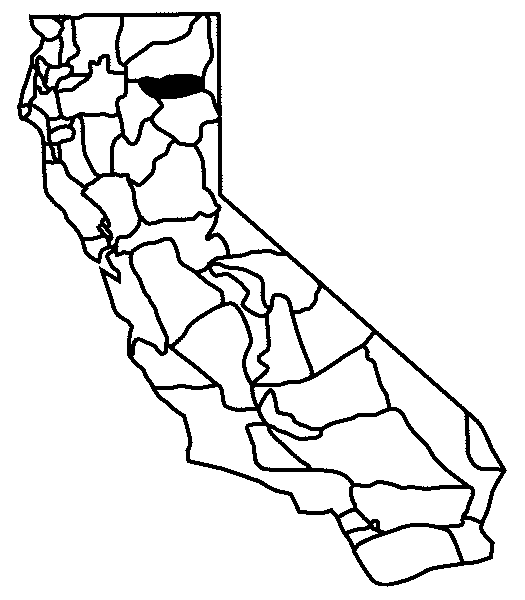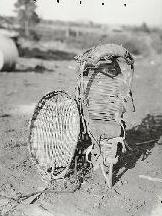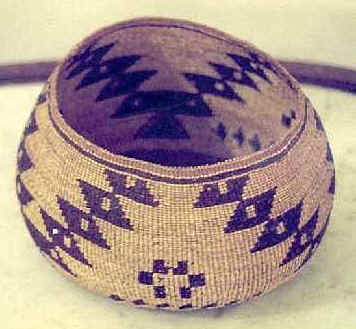Atsugewi
The Atsugewi (also Hat Creek Indians or Pit River Indians called ) are a tribe of Native Americans who lived in northeastern California. The Atsugewi included approximately 1,000 people. Today, they are organized in at the federal level as officially recognized tribes Pit River Tribe and the Susanville Indian Rancheria.
Socio - political organization
The Atsugewi were divided into two tribes. The one were the Atsugé ( = " pine-tree -people ", " pine - people" ), the. , The heavily forested western tribal region between Mount Lassen and the Pit River, with the main settlement area along the Hat Creek inhabited Because of this residential area they were mostly as Hat Creek Indians called. The others were the Apwaruge ( = "juniper -tree -people ", " juniper - people" ). They lived in the less forested, but marked by rich marsh and wetlands eastern tribal region along the Horse Creek. They were therefore often referred to as Horse Creek Indians.
In addition, the Atsugewi were divided into three social classes that were based on wealth and diligence ( which is generally accepted that the rich and the industrious are):
- Saswahecar ( commercial driving, and therefore hard-working rich )
- Wikoi ( the commons, the normals, " the common people ", the entourage of a Saswahecar, a rich man )
- Brumui ( the despised as lazy poor, for if they were diligent, they would have rich )
The social classes were in principle upwards and downwards permeable, but marriages were usually closed within social classes, so that the status (and the material wealth associated ) within the different classes belonging to families on inherited.
Way of life
During the summer Atsugewi lived in several semi-nomadic groups that lived by hunting, by fishing and collecting wild plants. In the winter they built along the rivers larger permanent settlements consisting of three to twenty-two covered with bark huts and dugouts. Many larger settlement may have counted up to one hundred inhabitants. Each settlement was autonomous and had one or more Bawi ( chiefs ), men had to get because of their great prosperity, their experience in hunting and fishing, their personality and their prestige, transfer leadership. The Bawi were responsible for the organization of hunting and fishing expeditions, and they shared with the residents of the settlements, when and where they had to collect various roots and plants.
The basis for the wealth of Bawi the possession of lands and other property (boats, nets, traps, metates ), which they sometimes lent to obtain this in turn presents ( killed wild game and artisanal products). The wealth of a man bemaß in the number of traded goods, pearls and furs.
Nutrition
The Atsugewie used seasonally over a hundred different plants and animals that were native to their territory. Here, the women were responsible for gathering and cooking of vegetables and roots, weaving baskets and mats. Men hunted, fished and cooked the meat. In addition, they established from fur garments.
The most important foods were salmon and acorns, nevertheless game was regarded as a food source with prestige and has been associated with wealth. Deer and antelope were hunted in the mountains during the summer, where deer were hunted by men and women, mostly in rural hunting parties. Deer were usually killed from ambush or by snares or traps that were designed along the water holes. In this pursuit of the hunters usually wore deer heads to hide can. Venison was eaten fresh or smoked and dried for winter and stored. Hunted deer and antelope were distributed among all members of the settlements. In addition, the Atsugewi small game, birds and waterfowl hunting. Fish was an important part of the diet dar. They hunt by basket traps, nets and spears various species such as salmon and pike. At night, fish were killed with a spear throws, boats. Just as wild fish was eaten either fresh or smoked and stored as dried fish for winter.
The following animals eat the Atsugewi either for religious reasons, not because they were considered taboo, or because they were not considered fit for human consumption: eagles, crows, frogs, coyotes, mink, gray foxes, and swallows (English Martin).
Important vegetarian foods were acorns, five types of sunflower seeds, Edible Prairie Lily roots and other roots and berries. Roots and nuts were processed into flour to it then make biscuits or porridge and store them for the winter.
Trade relations
With the neighboring tribes Atsugewi negotiated to obtain missing goods or for sale, in order to gain wealth, which was based on ownership of tradable goods, gave the prestige. Therefore, successful traders were mostly also Saswahecar or Bawi.
Language
The Atsugewi spoke Atsugewi, a branch of Palaihnihan that belongs to the family of languages of the Hokan languages. Their language was closely related to that of the adjacent Achumawi, but both strains could not communicate in this way. Since most Atsugewi but fluent Achumawi dominated, the two tribes agreed by this language. Today, there are hardly any speaker of the Atsugewi, but attempts are made to bring the language back to life.










